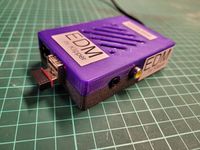Forskjell mellom versjoner av «HEDMA»
Hopp til navigering
Hopp til søk
(→Historikk / History: document test with aluminum) |
(→Historikk / History) |
||
| Linje 37: | Linje 37: | ||
; 2024-03-20 : tested with titanium (0.5 mm) but we had limited success, because our minimum feedrate (both plunging and X / Y moves) was too high. This seems to be a limitation of the controller. | ; 2024-03-20 : tested with titanium (0.5 mm) but we had limited success, because our minimum feedrate (both plunging and X / Y moves) was too high. This seems to be a limitation of the controller. | ||
| + | |||
| + | ; 2024-03-20 : Plans to test platform with original controller and a raspberry pi for klipper. I found an unused original pi1, single-core 700MHz 32bit ARM with w/256MB RAM in case it's missed. [[Bruker:Royk|Royk]] ([[Brukerdiskusjon:Royk|diskusjon]]) | ||
| + | |||
| + | ; [[Fil:rpi1-edm-klipper-v2.jpg|200px|thumb|right|hedma.local]] 2024-03-27 : The pi is setup with Debian a new chassis and labelled EDM m/Klipper. It has been given a 64GB SD card (I didn't have anything smaller) and a small 2,4GHz Wifi dongle. I also printed a case for it. Wifi (wlan0) is setup to use the bitraf24 network and the ethernet port (eth0) is configured with auto/dhcp. I didn't have a spare 5V adapter, so it needs some sort of power supply, but the rpi1 is easy to please there (as opposed to the v2 and v3). I did the last configuration for Bitraf with just a USB Micro charger at the large table in the lab and that works fine. Klipper is installed, but not configured for the correct board or at least, it's not by any means finished, but I need to find the machine before I can do anything more. Since I didn't find the machine, the Hedma pi is in my box. If someone really needs that pi1, please tell me or at least please unplug the SD card - It came out of my pocket and it's configured for this project. Thanks. [[Bruker:Royk|Royk]] ([[Brukerdiskusjon:Royk|diskusjon]]) | ||
== Referanser == | == Referanser == | ||
Revisjonen fra 27. mar. 2024 kl. 20:34
HEDMA is a hackable homemade EDM[1] machine.
Documentation is in the FabricateEDM[2] repository.
Innhold
Maskin / Machine
The machine is homemade, using existing machines and parts.
Motion platform
The motion platform is a Ultimaker 1[3] 3D printer.
Controller
We have replaced the original controller with an OpenBuilds Blackbox[4], and use an OpenBuilds Interface[5]
Power supply
We are using the Powercore V1. Manual[6], hardware[7], firmware[8].
Programware / software
EDMWeb[9] is the CAM software used.
Sikkerhet / safety
- do not touch when running
- stop cutting if a short occurs
- run only with dielectric fluid in the bath
Bruk / usage
The powercore guys made a nice video: Powercore V1 Quickstart Guide[10].
You need to have a dielectric fluid in the bath, de-ionized water is good. The workpiece is connected to the anode (positive side) and the tool to the cathode (negative side).
Plassering / location
The machine lives in a corner of the printer room.
Historikk / History
- 2024-03-20
- tested with 0.5 mm aluminium with success. The tool was 1.5 mm copper. Feedrate we think was 72 mm / min, because of the limit of the lowest pulse rate (240 Hz) that the avr 328p platform can generate with default grbl (with AMASS on. See grbl/config.h and
#define ADAPTIVE_MULTI_AXIS_STEP_SMOOTHING).
- 2024-03-20
- tested with titanium (0.5 mm) but we had limited success, because our minimum feedrate (both plunging and X / Y moves) was too high. This seems to be a limitation of the controller.
- 2024-03-20
- Plans to test platform with original controller and a raspberry pi for klipper. I found an unused original pi1, single-core 700MHz 32bit ARM with w/256MB RAM in case it's missed. Royk (diskusjon)
- 2024-03-27
- The pi is setup with Debian a new chassis and labelled EDM m/Klipper. It has been given a 64GB SD card (I didn't have anything smaller) and a small 2,4GHz Wifi dongle. I also printed a case for it. Wifi (wlan0) is setup to use the bitraf24 network and the ethernet port (eth0) is configured with auto/dhcp. I didn't have a spare 5V adapter, so it needs some sort of power supply, but the rpi1 is easy to please there (as opposed to the v2 and v3). I did the last configuration for Bitraf with just a USB Micro charger at the large table in the lab and that works fine. Klipper is installed, but not configured for the correct board or at least, it's not by any means finished, but I need to find the machine before I can do anything more. Since I didn't find the machine, the Hedma pi is in my box. If someone really needs that pi1, please tell me or at least please unplug the SD card - It came out of my pocket and it's configured for this project. Thanks. Royk (diskusjon)
Referanser
- ↑ EDM
- ↑ https://github.com/Fabricatable-Machines/FabricateEDM FabricateEDM
- ↑ https://reprap.org/wiki/Ultimaker Ultimaker
- ↑ https://openbuilds.com/builds/blackbox-motion-control-system.8320/
- ↑ https://openbuilds.com/builds/interface-cnc-touch-control-system.9688/
- ↑ https://github.com/Rack-Robotics/Powercore-V1.0-Manual
- ↑ https://github.com/Rack-Robotics/Powercore-V1.0-Hardware
- ↑ https://github.com/Rack-Robotics/Powercore-V1.0-Firmware
- ↑ https://github.com/Rack-Robotics/EDMWeb
- ↑ https://www.youtube.com/watch?v=FpUhpkBXa6Q
